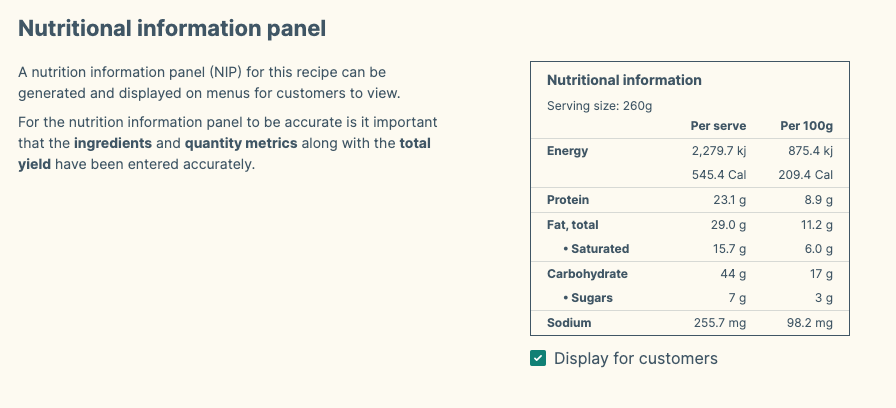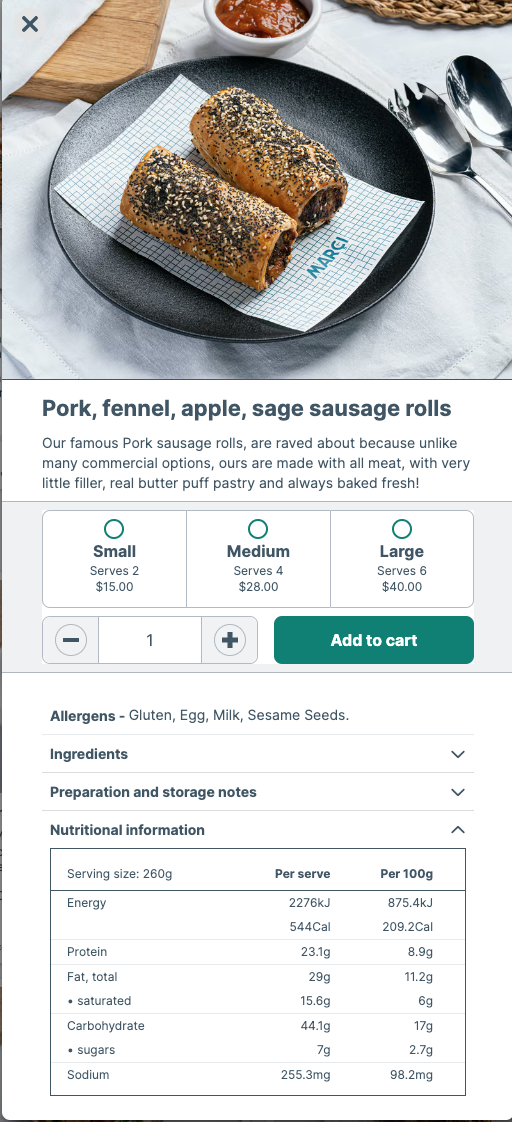Understanding Nutrition Panels
We're getting better at reading both nutrition panels and allergen statements these days. And Cookaborough creates your Nutrition Information Panels (NIPs) automatically every time you create a recipe! You can simply tick a box and voila! Your nutrition panel is available to view by your customers.
But understanding the information that's reported in a Nutrition Panel is useful - it can also help you design healthier meals or meals that suit your customers with specific dietary needs.
So let's break down all the macros in a NIP...

Fuelling Your Body Right: A Beginner's Guide to Carbs, Fats, and Proteins
The balance of macronutrients—carbohydrates, proteins, and fats—is a fundamental aspect of nutrition that plays a crucial role in supporting various physiological processes and maintaining optimal health.
Each of the macronutrients are not the same. Carbohydrates (45-65%), Protein (10-35%), and Fat (20-35%), These numbers are probably confusing and hard to understand without background knowledge. Let's break these down into numbers that are a bit easier to understand.
Carbohydrates
Australians should be consuming roughly 230-310 grams of carbohydrates a day. Carbohydrates are like fuel for your body, providing energy to keep you going. When you eat carbs, they turn into a type of sugar called glucose, which your cells use for energy, especially your brain. Besides giving you energy, carbs also help control your blood sugar, support your muscles when you're active, and help your body absorb important nutrients from food. They're important for keeping you healthy and feeling good overall.
To be healthy, it's important to focus on consuming complex carbohydrates, which are found in whole, minimally processed foods like whole grains (brown rice, quinoa, oats), fruits, vegetables, and legumes (beans, lentils, chickpeas). Avoid simple carbohydrates from processed and sugary foods like white bread, sugary cereals, sweets, pastries, and sugar sweetened beverages, as they provide empty calories and can lead to blood sugar spikes and health issues like obesity and diabetes.
Fats
Australians should be consuming roughly 44-78 grams of healthy fats a day. We need to eat fats because they have many important jobs in our bodies. First, they give us a lot of energy, more than carbohydrates or proteins. Fats also help make up the walls of our cells, which are like the building blocks of our bodies. They help make hormones, which control things like how fast we burn food and how we handle stress. Plus, fats help our bodies use certain vitamins that are important for staying healthy (did you know that fat aids in the absorption of vitamins A, D, E, and K?). They also help keep our bodies warm and protect our organs. And did you know, fats are really important for our brains too?
There are good fats and bad fats. Good fats, like mono and polyunsaturated fats found in foods like nuts, seeds, and fish, are good for your heart and overall health. They can help lower bad cholesterol levels and reduce the risk of heart disease. On the other hand, bad fats, like saturated and trans fats found in foods like butter, fried foods, and processed snacks, can raise bad cholesterol levels and increase the risk of heart disease. So, it's important to choose foods with good fats to keep your heart healthy!
Protein
Protein needs vary between women and men and change throughout life. For women aged 19-70, the recommended daily intake is 46 grams, while those over 70 should aim for 57 grams daily. Men typically require more, with adults aged 19-70 advised to consume 64 grams per day, increasing to 81 grams after the age of 70.
Proteins are essential for our bodies because they perform a variety of important functions. They act as building blocks for muscles, bones, skin, hair, and nails, helping us grow, repair, and maintain our tissues. Additionally, proteins serve as helpers in various chemical reactions, messengers that regulate our growth and metabolism, and bodyguards that protect us from harmful germs and viruses. In short, getting enough protein through our diet is crucial for keeping our bodies strong, healthy, and functioning optimally.
Protein can be found in both animals and plants. Animal proteins have amino acids similar to those in our bodies, but plants can also give us all the amino acids we need. In Australia, we get most of our protein from meat, poultry, and fish (about a third), followed by cereals like bread and pasta (about a quarter), and dairy products (about 16%). Vegetables also contribute a fair share, about 8%.
Getting NIPs right
A Nutrition Information Panel is a label on packaged foods - or displayed on online meals for preorder - that tells you what nutrients are in the food and how much of each nutrient is in a single serving versus 100 grams of the food. It helps you understand the nutritional content of the food and make healthier choices.
Let's take the example of these sausage rolls below: the NIP reveals that they contain 44 grams of carbs, 29 grams of fat, and 23.1 grams of protein per 260g serving. This allows consumers to gauge their nutritional value and incorporate them into their diet accordingly.
So it's a really good idea if you can manage to have all your recipes uploaded accurately into your account at the very least so that your customers so see exactly what they are purchasing! Uploading accurate Recipes with Ingredients that you have updated with costs will also allow you to more accurately determine the price you are charging for your meals. Book a meeting to understand how to glow up the accuracy of your Recipes.
Image courtesy of Marci
References
- Eat Better Health Gov (Year). Nutrient Reference Values. Department of Health, Australian Government. Available at: https://www.eatforhealth.gov.au/nutrient-reference-values/nutrients (Accessed: 5 April 2024).
- Food Standards Australia New Zealand (2023). Nutrition Information Panels. Food Standards Australia New Zealand. Available at: https://www.foodstandards.gov.au/consumer/labelling/panels
Need more help?
Online: Check out the 'Learn' tab on the Cookaborough home page for more tips, tricks and insights.
Email: If you have further questions or need assistance, contact our team.



